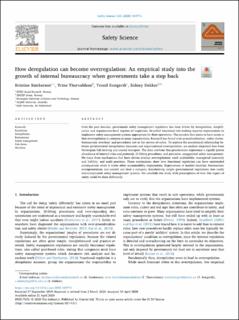| dc.contributor.author | Størkersen, Kristine Vedal | |
| dc.contributor.author | Thorvaldsen, Trine | |
| dc.contributor.author | Kongsvik, Trond | |
| dc.contributor.author | Dekker, Sidney | |
| dc.date.accessioned | 2020-05-29T11:40:30Z | |
| dc.date.available | 2020-05-29T11:40:30Z | |
| dc.date.created | 2020-05-17T07:53:36Z | |
| dc.date.issued | 2020-08 | |
| dc.identifier.issn | 0925-7535 | |
| dc.identifier.uri | https://hdl.handle.net/11250/2656029 | |
| dc.description.abstract | Over the past decades, government safety management regulation has been driven by deregulation, simplification and organization-level regimes of inspection. So-called functional rule-making requires organizations to implement safety management systems appropriate for their operations. The paradox that seems to have arisen is that overregulation is common in many organizations. Research has found over-proceduralization, safety clutter, bureaucratic overload, and procedures not at the service of safety. To explore the paradoxical relationship between governmental deregulatory measures and organizational overregulation, we analyze empirical data from Norwegian fish farming and coastal transport. The data confirms that practitioners experience a rapidly grown abundance of internal rules and protocols, ill-fitting procedures, and pervasive, exaggerated safety management. We trace three mechanisms that have driven internal overregulation: work auditability; managerial insecurity and liability; and audit practices. These mechanisms show how functional regulation can have unintended consequences when it meets other accountability expectations. Expectations of market doctrine, bureaucratic entrepreneurism and control can lead a company transforming simple governmental regulations into vastly overcomplicated safety management systems. We conclude our study with prescriptions of how this aspect of safety could be done differently. | en_US |
| dc.language.iso | eng | en_US |
| dc.publisher | Elsevier Ltd | en_US |
| dc.rights | Navngivelse 4.0 Internasjonal | * |
| dc.rights.uri | http://creativecommons.org/licenses/by/4.0/deed.no | * |
| dc.subject | Regulation | en_US |
| dc.subject | Deregulation | en_US |
| dc.subject | Bureaucracy | en_US |
| dc.subject | Safety management | en_US |
| dc.subject | Fish farms | en_US |
| dc.subject | Maritime | en_US |
| dc.title | How deregulation can become overregulation: An empirical study into the growth of internal bureaucracy when governments take a step back | en_US |
| dc.type | Journal article | en_US |
| dc.type | Peer reviewed | en_US |
| dc.description.version | publishedVersion | en_US |
| dc.rights.holder | © 2020 The Author(s). Published by Elsevier Ltd. This is an open access article under the CC BY license | en_US |
| dc.source.volume | 128 | en_US |
| dc.source.journal | Safety Science | en_US |
| dc.identifier.doi | https://doi.org/10.1016/j.ssci.2020.104772 | |
| dc.identifier.cristin | 1811369 | |
| cristin.ispublished | true | |
| cristin.fulltext | original | |
| cristin.qualitycode | 2 | |

